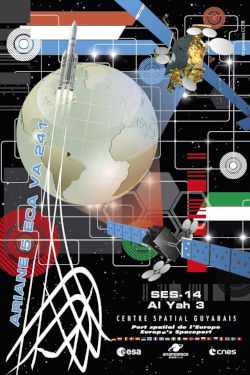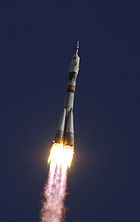
Arianespace SA is a French company founded in 1980 as the world's first commercial launch service provider. It undertakes the operation and marketing of the Ariane programme. The company offers a number of different launch vehicles: the heavy-lift Ariane 6 for dual launches to geostationary transfer orbit, and the solid-fueled Vega series for lighter payloads.

Soyuz is a family of expendable Russian and Soviet carrier rockets developed by OKB-1 and manufactured by Progress Rocket Space Centre in Samara, Russia. The Soyuz is the rocket with the most launches in the history of spaceflight.

The Guiana Space Centre, also called Europe's Spaceport, is a European spaceport to the northwest of Kourou in French Guiana, a region of France in South America. Kourou is located approximately 310 mi (500 km) north of the equator at a latitude of 5°. In operation since 1968, it is a suitable location for a spaceport because of its equatorial location and open sea to the east.

Vega is an expendable launch system in use by Arianespace jointly developed by the Italian Space Agency (ASI) and the European Space Agency (ESA). Development began in 1998 and the first launch took place from the Guiana Space Centre on 13 February 2012.

SES S.A., trading as SES is a Luxembourgish satellite telecommunications network provider supplying video and data connectivity worldwide to broadcasters, content and internet service providers, mobile and fixed network operators, governments and institutions.
Fregat (Russian: Фрегат, frigate) is an upper stage developed by NPO Lavochkin in the 1990s, which is used in some Soyuz and Zenit launch vehicles, but is universal and can be used as a part of a medium and heavy class launch vehicles. Fregat became operational in February 2000. Its liquid propellant engine uses UDMH and N2O4. Fregat's success rate is 97.3%, (with 2 failures and 1 partial failure), which makes it one of the most reliable upper stages in the world. Fregat has successfully delivered more than 300 payloads into different orbits. It remains the only upper stage in the world that can place its payload into 3 or more different orbits in a single launch.
AMOS-2 is an Israeli commercial second generation communication satellite, part of the AMOS series of satellites. The satellite was positioned at 4° West longitude in the geostationary orbit. Transmission and communication services given by this satellite include: direct distribution of television and radio translations to communication centers, distribution of internet services, data transmissions to communication networks. The new satellite, like its predecessor, will be positioned 36,000 kilometers above the Earth, and it will lie close to AMOS-1, so that the two can share a single space antenna.

Soyuz-2 is a modernised version of the Soviet Soyuz rocket. In its basic form, it is a three-stage launch vehicle for placing payloads into low Earth orbit. Compared to the previous versions of the Soyuz, the first-stage boosters and two core stages feature uprated engines with improved injection systems. Digital flight control and telemetry systems allow the rocket to be launched from a fixed launch platform, whereas the launch platforms for earlier Soyuz rockets had to be rotated as the rocket could not perform a roll to change its heading in flight.
O3b Networks Ltd. was a network communications service provider building and operating a medium Earth orbit (MEO) satellite constellation primarily intended to provide voice and data communications to mobile operators and Internet service providers. O3b Networks became a wholly owned subsidiary of SES in 2016 and the operator name was subsequently dropped in favour of SES Networks, a division of SES. The satellites themselves, now part of the SES fleet, continue to use the O3b name.

The year 2011 saw a number of significant events in spaceflight, including the retirement of NASA's Space Shuttle after its final flight in July 2011, and the launch of China's first space station module, Tiangong-1, in September. A total of 84 orbital launches were conducted over the course of the year, of which 78 were successful. Russia, China and the United States conducted the majority of the year's orbital launches, with 35, 19 and 18 launches respectively; 2011 marked the first year that China conducted more successful launches than the United States. Seven crewed missions were launched into orbit during 2011, carrying a total of 28 astronauts to the International Space Station. Additionally, the Zenit-3F and Long March 2F/G carrier rockets made their maiden flights in 2011, while the Delta II Heavy made its last.

The Ensemble de Lancement Soyouz (ELS) is a launch complex at the Guiana Space Centre in Kourou/Sinnamary, French Guiana. It was used by Soyuz-ST rockets: modified versions of the Soyuz-2 optimised for launch from Kourou under Soyuz at the Guiana Space Centre programme.

O3b is a satellite constellation in Medium Earth orbit (MEO) owned and operated by SES, and designed to provide low-latency broadband connectivity to remote locations for mobile network operators and internet service providers, maritime, aviation, and government and defence. It is often referred to as O3b MEO to distinguish these satellites from SES's forthcoming O3b mPOWER constellation.
Arabsat-5A is a Saudi Arabian communications satellite operated by Arabsat. It will be used to provide television, internet and telephone services to Arabia, Africa and Europe.
Hot Bird 7 was a communications satellite that was lost in a launch failure in 2002. Intended for operation by Eutelsat, it was to have provided direct-to-home broadcasting services from geostationary orbit as part of Eutelsat's Hot Bird constellation at a longitude of 13° East. Hot Bird 7 was intended to replace the Hot Bird 3 satellite, which had been launched in 1997.

Soyuz at the Guiana Space Centre was a European Space Agency (ESA) programme for operating Soyuz-ST launch vehicles from Centre Spatial Guyanais (CSG), providing medium-size launch capability for Arianespace to complement the light Vega and heavy-lift Ariane 5. The Soyuz vehicle was supplied by the Roscosmos with TsSKB-Progress and NPO Lavochkin, while additional components were supplied by Airbus, Thales Group and RUAG.
SES-17, is a high throughput all electric geostationary communications satellite owned and operated by SES S.A., and designed and manufactured by Thales Alenia Space. Launched on 24 October 2021 from Centre Spatial Guyanais (CSG), in Kourou, French Guiana by an Ariane 5ECA launch vehicle, SES-17 was positioned at 67.1° west in May 2022 and, after testing, became fully operational in June 2022.

Ariane flight VA241 was an Ariane 5 space launch that occurred from the Guiana Space Centre on 25 January 2018 at 22:20 UTC.
O3b mPOWER is a communications satellite system owned and operated by SES. The system uses high-throughput and low-latency satellites in a medium Earth orbit (MEO), along with ground infrastructure and intelligent software, to provide multiple terabits of global broadband connectivity for applications including cellular backhaul and international IP trunking, cruise line connectivity, disaster recovery, and military communications. The first O3b mPOWER satellites were launched in December 2022 and the system became operational in April 2024 with 6 satellites. The system's capacity will be increased by a further 7 satellites launched by 2026.













